
The Secret to Landscaping Around Trees
Published: 18/01/2023 | Updated: 17/05/2023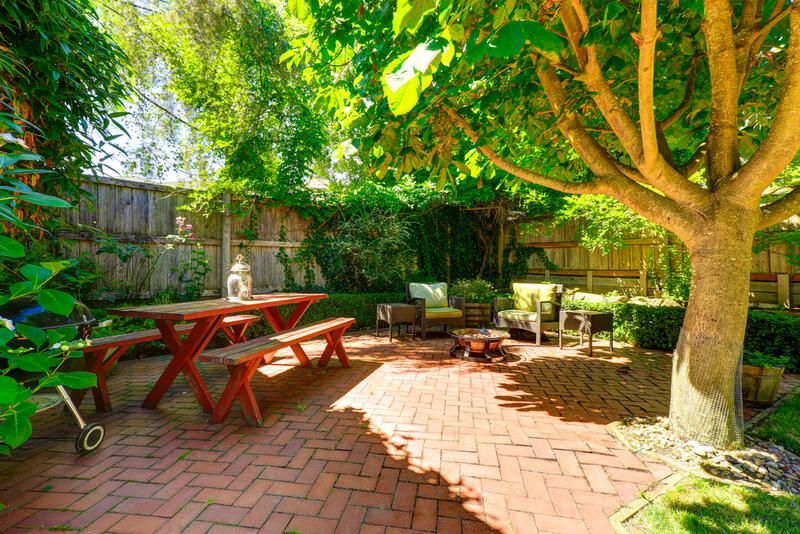
The soil around and beneath a tree is frequently neglected, leaving bare dirt, exposed tree roots, and a few unwelcome volunteer plants. Learn how to design a neglected area to enhance the beauty of the tree and the space it shades.


There isn't a one-size-fits-all approach to solving problems. When dealing with dry soil, irrigation (too much or too little), shadow, a little amount of space (those roots! ), and dappled light, there is a fear of injuring the tree's roots. Remember that not all landscaping needs plants; hardscapes, such as decks, gravel, or mulch, may be the perfect solution.
Traditional landscaping techniques included edging a tree with brick, stone, or rubber. Impatiens, begonias, and perhaps a few shade-tolerant bulbs might be planted if you wanted to get creative—until the area was overrun with weeds, the snails and slugs moved in, or it started to look dreadful. The outcomes are frequently unexpected; you don't anticipate anything being planted there, but when it does, you discover that there is unoccupied space there that is simply waiting to be beautified.
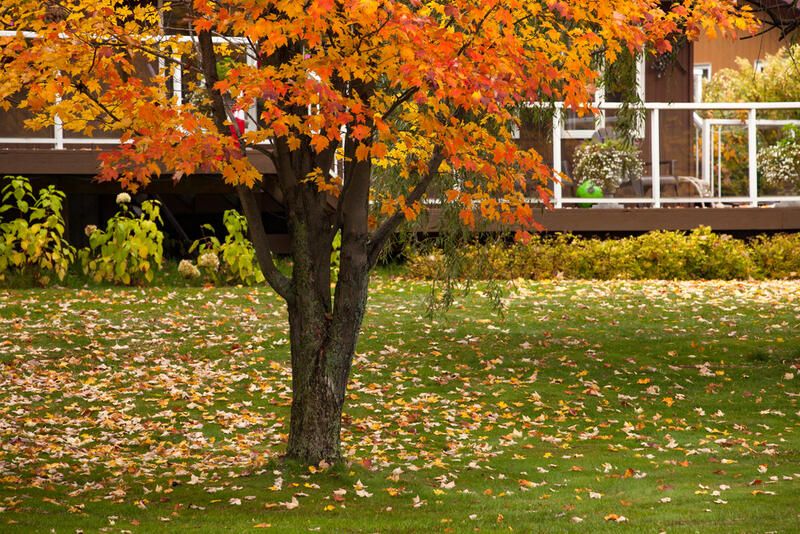
Get motivated by these creative and lovely tree-related landscaping ideas.
Landscaping Around Trees Ideas
Try a Shade Loving Plants
A shade tree may just have to be the tree you are looking for! You may have once shied away from decorating the trunk of your tree with lovely flowers out of concern that the shade will undo all your labor of love. But put on your gardening gloves and bring out your trowels because there are lots of plants for your shade garden that will like the area under your tree. Some of the top plants for a shady garden include the following:
-
Impatiens
-
Coral bells
-
Hosta
-
Coleus
Consider building a stone walk that leads you through the garden after adorning your trees with a lovely garden area.
A path greatly improves accessibility to your shade garden and encourages guests to explore more closely without trampling new plants.
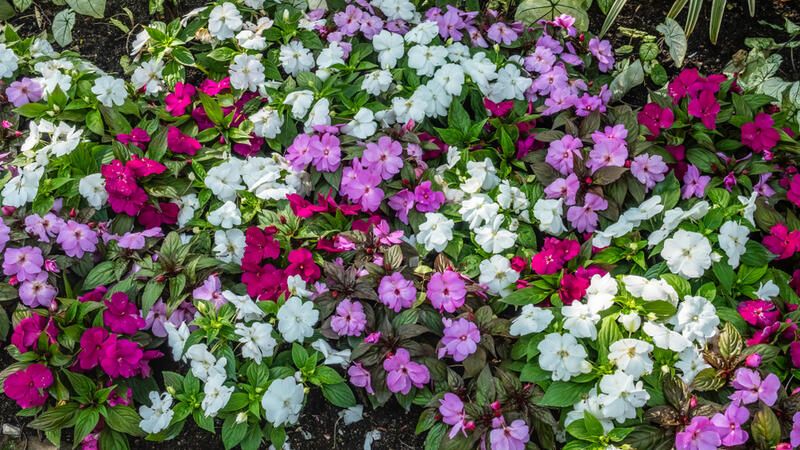
Create Seasonal Interest
Even when a tree is barren, landscaping can still provide interest in the area. Early bulbs will sprout before the tree has all of its leaves, so you won't have to worry about fighting against shade. Naturally, it's difficult to underplant a tree because there's a risk of injuring the tree's roots.
Make careful to completely mulch the tree's base with organic material before you begin so you have room to plant the bulbs without injuring the roots.
Plant a variety of bulbs, starting with the early-blooming snowdrops, winter aconites, and crocuses, then moving on to snowflakes, fritillaries, narcissi, tulips, alliums, and camassias. Under trees and bushes, Muscari or grape hyacinths grow nicely as native plants. For a lovely combination, combine with primroses, daffodils, pansies, and early tulips.
Your bulbs will keep growing, multiplying, and reappearing every year once they are planted, making them a low-maintenance way to create flower landscaping around trees. Additionally, you can continue to mulch, feed, and water your trees as necessary since once they have completed blooming, the bulbs will go back underground.
Just Add Mulch!
A layer of mulch at the tree's base conceals exposed roots and provides more color. What color? How does the mulch look? On you, everything is dependent.
You'll get splashes of color in the spring if you put crocuses or other flowers in the mulch surrounding your tree. Or stick with hostas to provide some green to the mulch underneath your tree's greenery that is brown or another hue. One of the simplest and most affordable ways to add a splash of color and flare around your trees is with mulch.
Pro tip: Keep the mulch volcano around your tree at bay. Mulch should not be layered any thicker than 2-3 inches and should be kept about 6 inches away from the tree's base. The roots will be able to maintain a strong oxygen exchange with the soil as a result. Additionally, it will stop the trunk's bottom from splitting, which can result in issues with insects, rodents, and diseases.
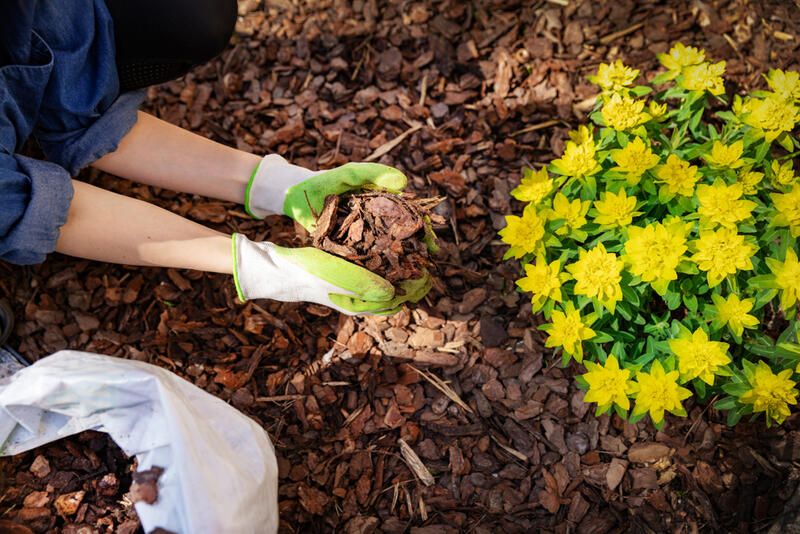
Deck Tree
Why not have a tree growing through your outdoor living space? You've probably heard of trees growing inside houses. The dramatic impression added by constructing your patio or deck around a tree will make your neighbors envious that you came up with the idea first.
As you relax on a couch within 2 feet of a huge plant, a tree growing right from your outdoor living area fosters an even deeper connection with the environment. A tree on the deck or patio will not only bring excitement and tranquility but will also offer wonderful shade and protection.
Remember that a tree that grows in your outdoor living area may require a lot of upkeep. Trees frequently alter shape as they mature, which could have an impact on the space of your patio or deck.
Attention: If a tree's trunk keeps expanding, your deck's boards could break. Additionally, trees may make your wooden construction more susceptible to termites and produce tree litter that needs to be cleaned up.
Is this healthy for your tree?
A tree can benefit from having a patio or deck built around it. One advantage of a wood deck surround is that it:
-
Lessening of soil compaction at the tree's roots. Years of foot traffic compaction can be stressful. A deck reduces compaction to a minimum or acts as a buffer.
-
Wood decks that are elevated reduce foot traffic on the ground beneath trees.
-
Water and oxygen may easily reach the soil and roots through the tiny spaces between the planks.
-
Leaves will still be able to recycle nutrients back into the soil by slipping through the board cracks.
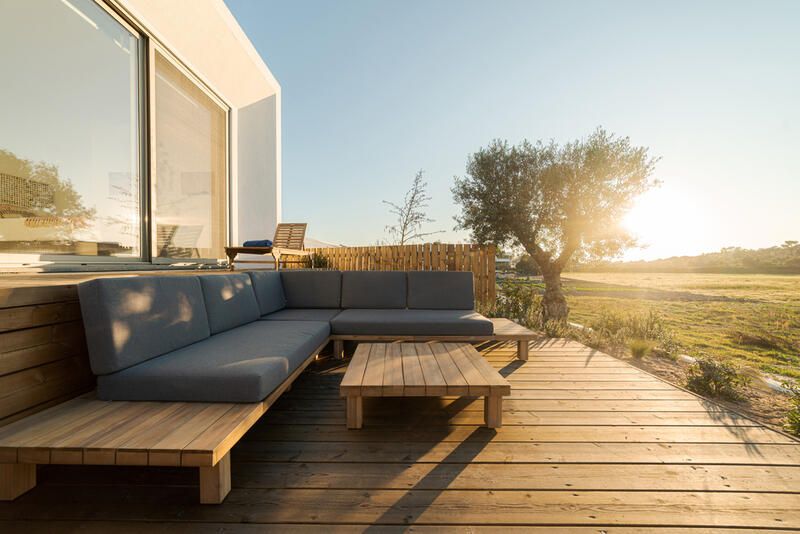
Simply Add a Bench
A circular bench positioned around a huge tree not only offers a shady area for relaxation but also draws the eye to that particular area of the garden. Many companies provide beautiful tree benches, ranging from elaborate cast-iron designs that have an ancient feel and lend traditional elegance to your environment to hardwood versions that add typical country charm. This is a rather easy landscaping concept for surrounding trees.
Even more stunning gifts that will last for many years are available with customized designs.
Decorate the Area Beneath
This landscaping idea is quite simple to implement. There are numerous ways to embellish the tree's base. You can use mulch, plants that do well in shade, a rock garden, or any number of other fantastic ideas to give your trees curb appeal and a unique touch. We will go into some of these in greater detail.
Then, for a pop of color, whimsy, and fun, you can add garden ornaments, coral bells, and other such items. A space can be much improved by a few inches of mulch, a few tiny stones, drought-tolerant groundcovers or succulents, and some excellent lawn decorations.
Plant Some Flower Beds
In your yard, your tree does not need to be the only one. For your tree, flowers provide some company. Under all those branches, in partial shade, are yellow daffodils or pink, purple, or scarlet petunias that will catch your and your guests' attention.
Create a flower bed in your front or back yard with your tree as the centerpiece and high point (literally) if you want to go nuts.
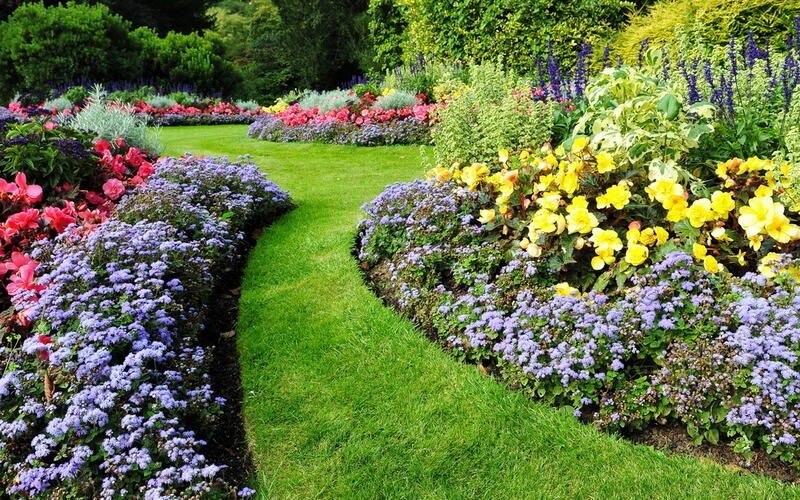
Try Hedging
By constructing a low hedge border around your trees, you may give your yard a sense of order. It neatly frames the area and is reminiscent of traditional parterre designs.
Framing your trees with a box or privet hedging will provide visual interest and serve to limit the bed into which your trees are growing if you've used loose mulch, such as bark chippings or slate, to control weeds.
When used over a larger area rather than only near a single tree, this design works particularly well to conceal the seam between two different ground surfaces, such as a walkway and plant border or a lawn and plant border.
Build a Tree Ring
Making a tree ring is a common component of the concepts we are discussing here. You can use pavers, cinderblocks, pebbles, bricks, and more to do this. Build your tree ring with the tree's health in mind, no matter what materials you decide to use. A minimum of 8 to 10 inches must be removed from the tree trunk. Mulch, pine cones, or other materials can be used to fill your tree ring as long as they won't harm the tree or its roots.
Build a Retaining Wall
A retaining wall around your tree can provide a spectacular focal point that increases your curb appeal while giving the yard a uniform appearance. A retaining wall built of pavers or stone would provide tremendous beauty and charm to your tree instead of bare roots and uneven grass at the base.
Retaining walls are another inventive (albeit expensive) solution to erosion issues or uneven terrain next to your tree.
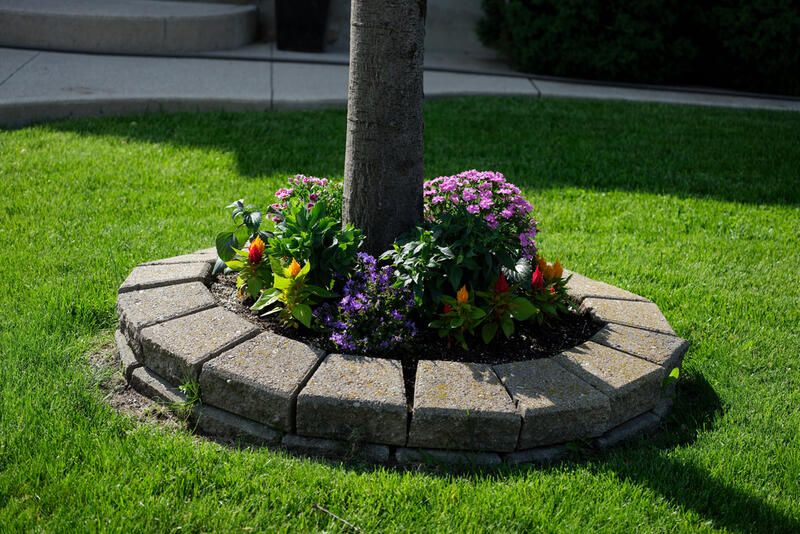
Night Lighting
Why allow your efforts to be lost once the sun sets? When done properly, outdoor landscape lighting may showcase the architecture of your home, highlight the design around your trees, and even offer security when you need to go outside.
Another fantastic choice is to use landscape lighting to create ambiance around your trees. Do you have plans for a relaxed supper with friends? Make some drinks, turn on the light, and extend the invitation to everyone for a relaxing evening on the deck.
Who wants to be concerned that guests might bring flying insects inside the house? Turn off the lights at the door and let the sky be illuminated by the nearby trees.
Incorporate Trees into Your Decking
Deck designs are excellent for landscaping near trees since they require the least upkeep over time. If you add a decked area to your yard, you have a lot of design options. It is a gentler alternative to asphalt and works well with trees and other plants to provide the perfect setting for relaxation.
Because the deck has been raised, weeds won't grow around the tree's base, and it's doubtful that the tree's roots will affect the deck's stability as it grows.
Create a Walkway
To make a path to and from your tree, you can use paver stones, bricks, landscaping pebbles, or other materials. For more interest, decorate the sides of the walkway with vibrant flowers and plants.
You can combine this suggestion with others on the list. For instance, you might mulch the area around the tree's trunk, install a bench there so people can sit in the shade, and then add a stone pathway to connect everything.
You can space out paver stones to provide a walkway that passes in between the roots if you're trying to work around existing roots. Smaller trees will have smaller roots than larger trees, so you may plan appropriately. You should also be aware that when roots swell over time, certain pavers or stones may be pushed aside. As the seasons and years go by, you might need to redesign your pathway.
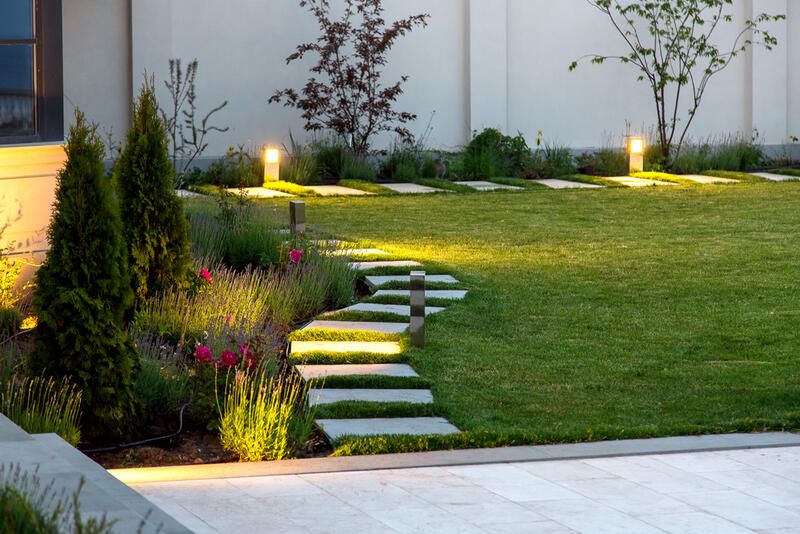
Add a Succulent Garden Bed
Even while the majority of succulents enjoy the sunshine, prolonged exposure to it and extremely hot temperatures can cause these plants to burn. Due to its ability to shield them from excessive sunlight and hot weather, your tree is essential to its development.
Given that these plants come in a wide range of sizes and forms, a succulent garden may offer beautiful texture and color to your landscape. It's crucial to understand fundamental gardening advice for succulents before getting your hands dirty and creating a garden next to your tree.
Landscape Around Trees (Espaliered)
Espaliered trees have a broad, rectangular border at the base because they are trained to grow up against a wall. The area beneath the tree is less shadowed than under a typical tree because it is flat to the wall.
When choosing plants for landscaping around trees, choose ones with shallow roots so as not to affect the tree's root structure. For underplanting trees, try lavender, zinnias, pansies, or marigolds.
Rock Gardens
Rock gardens can be used in a variety of ways to beautify the space around a tree's base. If you already have plants in other areas of your yard, rocks and bricks can make excellent plant substitutes. Instead of using live plants when you need to improve the landscaping around a tree, think about using rock gardens.
While pebbles are a terrific choice for a tree's foundation, it's crucial to use them properly or you risk killing the tree. Before setting your rocks, you should leave at least 8 to 10 inches around the tree trunk clear.
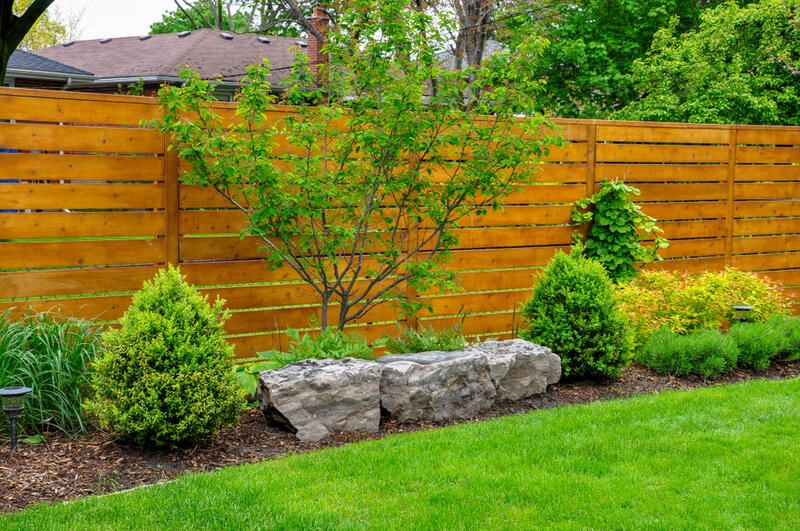
Work Around Tree Roots
Working around the existing tree roots is an additional option. In addition to posing a trip risk, exposed tree roots can also detract from the aesthetic attractiveness of your landscaping. A headache to mow around is exposed roots. If you attempt to cover the tree roots, it could suffocate them and cause the tree to die.
You should instead come up with some inventive techniques to get past the tree roots. Using groundcover plants is one approach to accomplish this. These may be inserted between the roots without injuring them, and as they spread out, the groundcover plants will cover the roots on top, giving them a pleasing appearance while not suffocating them and still allowing air to reach the exposed root sections. Consider the following examples of groundcover plants:
-
Sweet woodruff (gallium odoratum)
-
Creeping Liriope (liriope spicata)
-
Yellow Archangel (Lamium galeobdolon)
-
Bunchberry (Cornus canadensis)
-
Garden ferns
Use of an invasive species in your area should be avoided. For instance, English ivy is frequently utilized in low-light locations but has spread widely across the United States.
Organic mulch can also be placed around exposed tree roots without endangering them or suffocating them. To conserve the roots while still giving people a secure place to stroll, you might alternatively build a boardwalk or a stone pathway over them.
Serene Getaway
It's the ideal place to set up a private area to relax with a book, a cup of tea, or a notebook because of the cool shade provided by your tree. This peaceful area can be transformed into a sanctuary that is exclusively for you.
Do you want to take a cozy seat on a bench or do you prefer to relax in a hammock? As you unwind outside and enjoy your outdoor space, what plants would you like to have nearby? Perhaps a modest water feature by your feet or a birdbath to draw additional avian companions to your yard would help you feel just right.
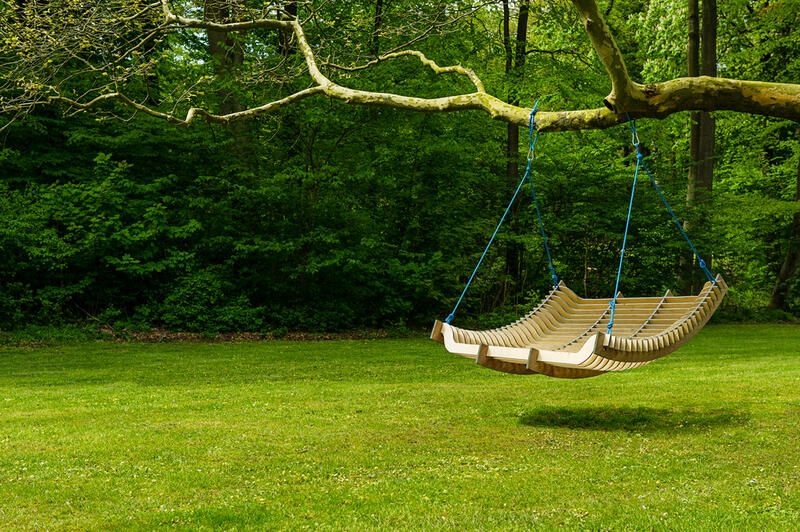
FAQs
How Can the Weeds Around My Tree Be Controlled?
Keep the weed eater and lawnmower inside the garage. Using machinery to eradicate weeds can seriously harm your tree. A mower or trimmer's blades could cut into the tree's root and possibly obstruct the flow of water and nutrients to the tree. Additionally, a wound in the wood or bark makes your tree more susceptible to a fungus infection.
Mulching or using pesticides are safer options for weed control around your tree. Mulch inhibits the growth of weeds by shielding them from sunlight.
Can I Landscape Around Exposed Roots?
Mulching can be a terrific technique to landscape around your tree and hide its roots. Consider creating a walkway around the tree roots to orient visitors and create a safer path to assist prevent tripping.
Although adding more dirt can seem like a good idea, your tree will become suffocated if you do so. Your tree's roots require oxygen to breathe just as you do. Stay with the mulch and avoid adding a thick layer of dirt.
Are Exposed Roots Bad?
Your tree may be more vulnerable to a mower's cutting edge if its roots are exposed. When machinery damages a tree's roots, there are exposed sores that make the tree vulnerable to disease.
In addition to lifting structures and posing a tripping danger, exposed roots can also inhibit grass from growing.
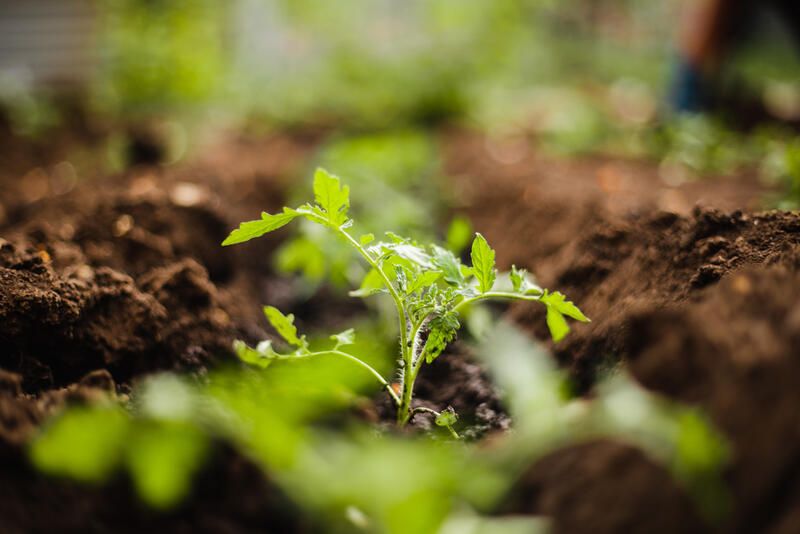
How Much Organic Mulch Should I Use?
The University of New Hampshire Cooperative Extension advises applying mulch around your tree in a uniform layer 2 to 3 inches deep. Avoid adding more mulch than 3 inches thick because doing so could damage your tree.
At the very least, the mulch should reach the tree's drip line, which is the area around the tree canopy where water drips onto the ground. Mulch should not be piled up against the tree trunk because this will only encourage disease, pests, rodents, and root issues. To ensure proper airflow, keep the mulch at least 6 inches from the base of the trunk.
When to Call a Professional
While many of these tree landscaping ideas make for enjoyable do-it-yourself undertakings, employing a landscape architect is a wise choice. Shrubhub.com has become a recent favorite for a lot of homeowners.
Working with a professional helps you avoid making expensive mistakes, gains additional landscaping suggestions, and ensures that you are not jeopardizing the health of your tree.
The last thing you want to do is create your landscape plan only to discover later that poorly managed curb appeal hurt your favorite tree. Shrubhub.com allows you to fully digitize your yard in 3D so you can play around with as many options as you want without having to commit right away!


